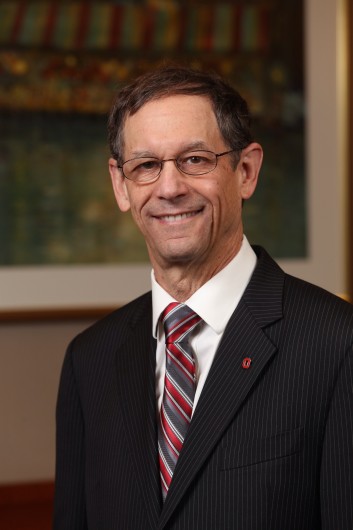
The OSU Wexner Medical Center is located at 410 W. 10th Ave.
Credit: Lantern file photo
Dr. Sheldon Retchin, the CEO of the Wexner Medical Center, resigned Tuesday afternoon, just days after coming under public scrutiny following a string of letters to university leadership criticizing his job performance.
The letters were signed by many of Ohio State’s most prominent doctors and professors within the Wexner Medical Center and College of Medicine, and were sent to University President Michael Drake, Provost Bruce McPheron, members of OSU’s Board of Trustees and the chairman of the medical center’s board, Les Wexner.
The letters offered sharp criticism of Retchin, and the authors of one letter, dated May 1, wrote they had “no confidence” in his leadership and management. They outlined several issues, most notably questionable hiring practices and poor collaboration between the Wexner Medical Center and the James Cancer Hospital and Solove Research Institute, leading to an “Us vs. Them” atmosphere and culture.
Retchin cast doubt on the truthfulness of the letters’ claims in a statement accompanying his resignation.
“In response to recent events, more specifically to letters regarding my leadership here — that have been made public — I must clear my name and address these preposterous allegations by simply and unequivocally stating that they are untrue,” Retchin said in a statement.

Dr. Sheldon Retchin
Credit: Courtesy of OSU
The series of letters had led to multiple meetings up until Tuesday between the doctors who signed them and OSU officials including Drake and McPheron, according to university spokesman Chris Davey.
Davey said that meetings were held with doctors and different parties involved to further communication on the concerns voiced in the various letters.
On Monday, just a day before Retchin’s resignation, Davey said they were optimistic and encouraged by progress in talks.
Ultimately, those talks culminated with Retchin’s short-lived tenure coming to a close, though both he and the university assert the allegations were untrue.
“Although allegations raised in letters sent to the news media this week were untrue, these letters may have damaged important relationships necessary for continued future success, and Dr. Retchin has chosen to move on in the best interests of the university, himself and his family,” OSU said in a statement announcing Retchin’s departure.
The first letter — signed by 25 physicians and professors within the university, many of whom are division heads — claimed that Retchin’s leadership style does not align “with the university’s values of excellence, integrity, transparency and trust.”
“Over the past three years of Dr. Retchin’s employment, we have witnessed a continuing decline in faculty morale and erosion of mission focus,” the letter stated.
The first letter also claimed that Retchin’s leadership and management, as well as that of Dr. K. Craig Kent, the College of Medicine’s recently appointed dean, have led to senior faculty resignations and early retirements.
In turn, the letter asserts that those factors have culminated in “significant delays in filling vacant positions left by multiple departing faculty. This has created physician understaffing which endangers patient safety and lowers the quality of care.”
“These baseless accusations have damaged me and the University I love,” Retchin said. “I cannot allow this to continue and so I have decided that it is in the best interest of the institution and me and my family to step aside, effective immediately. I will be taking a leave of absence and then will assume a new role at the University to pursue health policy research and teaching.”
Retchin was hired by OSU in December 2014. He had previously served for 11 years as the senior vice president for health sciences at Virginia Commonwealth University and the CEO of its health system.
Both Drake and Wexner praised Retchin’s hiring in 2014. Drake said at Retchin’s introductory press conference that a national search, which included 150 initial candidates, was held to fill the highly sought-after position of running one of the country’s top-ranked academic medical centers.
In fact, Retchin’s hiring was cited by the Board of Trustees as reason for Drake’s first $200,000 bonus, received in 2015 and again in 2016.
Following the initial letter, a pair of letters were sent out on May 3 from other departments within the medical center, noting the same concerns identified with Retchin and Kent.
In one letter, a group of five department chairs and the director of the medical center’s Neurological Institute echoed the same sentiments, stating “the cultural environment of Ohio State’s WMC and the College of Medicine is increasingly characterized by low morale, distrust and a sense of alienation.”
In the second letter, the chairs of six clinical departments continued to repeat what their colleagues had put forward in their own letter drafted to the same audience.
“Please understand that we have made every attempt to address these issues with our leadership team but have been met with resistance,” they wrote in the letter.
The letter from May 1 states that more than 100 faculty supported the letter and would have signed it but did not for fear of “retaliation with contracts that allow for immediate termination.”
The medical center, no longer under Retchin’s guidance, employs over 1,200 physicians and sees over 60,000 patients each year, according to its website. In addition, the center has an operating budget of $2.57 billion.


